 PLACES OF INTEREST PLACES OF INTEREST |
 KHARTOUM - THE CAPITAL KHARTOUM - THE CAPITAL |
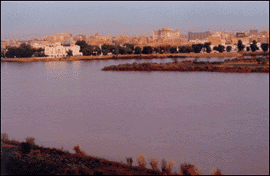
Khartoum is located on the junction of the White and Blue Nile, latitude 15,36 N, longitude 31,32 E, some 1352 ft above the sea level. It enjoys high temperatures in summer, moderate and dry climate in winter, and sandstorms are quite common during the rainy season in July and August.
Khartoum has 7 million inhabitants and it consists of three cities in a rectangular form:
-Khartoum: administrative ad political capital
-Omdurman: as national capital
-Khartoum North: third city
These cities form the Khartoum State triangle with the two Niles coupling in its heart and the eternal Nile River that keeps flowing and flowing.
There are several tourist attractions and significant sites to be seen in Khartoum and around:

 Republic Palace Republic Palace |
This was a seat of the governor general during the British rule. Now it is the seat of the command and centre of running the country's government affairs and highlights the republican regime.
 Khartoum University Khartoum University |
The oldest university with a prestigious world wide reputation -it was once a sister-university of Cambridge. Significantly, Sudan boasts more than 30 government and private universities specialised in Islamic sciences, such as the Islamic University and the Holy Koran University.
 National Museum National Museum |
It is the largest and most important museum in Sudan and features all the important periods in history of the country. Objects to be found here are ceramics, jewellery, other handicraft, sculptures and paintings.
Fee 50 dinnars
Open every day 8.30 a.m.-8.30 p.m. (except Monday)
 House of Khaliffa House of Khaliffa |
The house was built between the years 1887-1891. It was the official residence to the Khaliffa during the Mahdi administration. The house was transformed into a museum in 1928. Objects are from the period before, during and after Mahdi.
Fee 25 dinnars
Open 8.30 a.m.-6 p.m. every day
 Ethnography Museum Ethnography Museum |
This museum best portrays the variety of Sudanese tribes and cultures. Even if it is divided into different cultures in the Sudan, it still very well shows the cultural and historical bonds in the country.
Fee 25 dinnars
Open 8 a.m.-6 p.m. (except Monday)
 Sablouka Falls Sablouka Falls |
A patch of cascades on River Nile north of Khartoum, it is an enchanting portrait and presents a suitable site for boat rowing amateurs.
 Sunut Forest Sunut Forest |
Located on the White Nile bank where two Niles converge, this wood is an attractive tourist resort.
 Jebal Aulia Dam Jebal Aulia Dam |
Sprawling south of Khartoum o the White Nile, this area embraces the Dam and is renowned as a fishing site.
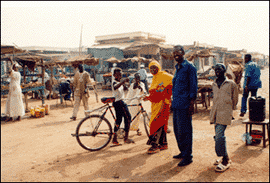
 Important Markets Important Markets |
Khartoum Grand Market, Omdurman market, Bahri market, other central ad popular markets, as well as Libya market which sells savory camel meat
 Nilen Mosque Nilen Mosque |
This mosque with a jewel shaped dome overlooking the Nile coast houses the Holy Koran University. "Whirling Dervishes" dance here an hour before the sunset on Fridays, and it is a very beautiful and interesting spectacle; not to be missed!
 Imam Mahdi Dome Imam Mahdi Dome |
Khartoum is celebrated for its numerous vaults commemorating the righteous, as is the Imam Mahdi Dome. Imam Mahdi was a political and spiritual leader, and a liberator of Sudan from foreign domination that led to the Mahdi State during the period 1885-1898. The dome itself is an impressive monument, which witnesses on each Friday afternoon a festival of decorated traditional garments and chanting hymns not failing to make a presence, so it is well attended by many tourists.
 OTHER CITIES AND SITES OTHER CITIES AND SITES |
 Atbara Atbara |
The main draw of Atbara is that it is near the Nile's Fifth Cataract. Plan few a hours there -enough time to see the cataract and the old steam locomotives that died and are rusting in railyards. It is 277 km form Khartoum.
 Dinder National Park Dinder National Park |
This medium size reserve (6475 hectares) is in the eastern Sudan, on the border with Ethiopia. Lions, monkeys, giraffes, leopards, bushbucks, kudus, antelopes and many kinds of birds can be seen here, but one needs his own vehicle. Some tours might be organised during the high season from December to April. It is 400 km south east of Khartoum.
 Dongola Dongola |
On the Nile in the northern Sudan, this town lies in a noted date-growing area. Across the river are the ruins of the Temple of Kawa. Dongola is served by bus and steamer, though during winter months only. It is 457 km north east of Khartoum.
 El Obeid El Obeid |
The self-proclaimed "gum arabic capital of the world", El Obeid is a fairly large desert city with population of 140 000 people. It has a small history museum, two markets and interestingly enough, one of the largest cathedrals in Africa. Attend a Sudnau service even in you are not religious! For the whole trip, plan one night. It is 367 km south west of Khartoum.
 Erkowit Erkowit |
Located in the beautiful Red Sea Hills, Erkowit was once a cool retreat for the British. There are, however, few original buildings left; it is just a place to go to get out of the heat for a while. The area can be reached by private vehicle. It is 100 km south of Port Sudan.
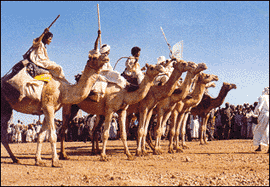
 Imatong Mountains (Matong) Imatong Mountains (Matong) |
When reopened, this area on the border with Uganda will be worth of a visit for its cool climate and interesting tribal people. Like Erkowit, Matong was also a British hill station. Currently, the region is in rebel territory and considered unsafe to visit.It is 129 south east of Juba.
 Jebel Mara (Jabal Marah) Jebel Mara (Jabal Marah) |
This splendid region of small mountains in Darfur Province in the western Sudan is popular with trekkers. In the centre of Jebel Mara is an extinct volcanic crater with a lake called the Eye of Jebel Mara. Most visitors come here by a truck from Nyala. The mountain itself is the highest peak in the Darfur region; 3088 m. It is 120 km north west of Nyala.
 Juba Juba |
Capital of Equatoria Province and terminus for Nile steamers, Juba with a population of 116 000, is a place to visit if the political situation is stable. It is the heart of the South and surely interesting at least for those interested in politics as it has been surrounded by the war for so many decades. |  Karima Karima |
This small market town on the Nile north of Khartoum is near the ruins, a small temple and pyramids, of Jebel Bakal. Further South in Kurru are other interesting antiquities: underground tombs with paintings. Just across the Nile by ferry are the ruins of Merowe (not to be confused with Meroe), the site of the ancient capital of Napata. Karima cannot be reached by road, but it is on the railway. It is 338 km north-north east of Khartoum.
 Kassala Kassala |
Surrounded by strange jebels, rounded hills, Kassala of 149 000 inhabitants, has an active souk (market) selling locally made handicraft like jewellery, knives and swords. Women of the Rashida tribe, descendants of 19th century immigrants from Saudi Arabia make the silver jewellery. Kassala can be reached by bus from Khartoum or Port Sudan and it is 405 km from Khartoum.
 Kosti Kosti |
South of Khartoum on a new road, Kosti sits in an area that is usually considered safe. Visit the Kenana Sugar Project, as well as the Mahdi's Mosque on nearby Gezira Aba Island. Try the local fish from the Nile at one of the restaurants. The Nile steamer that used to travel from Kosti to Juba is not currently in service. Kosti is 310 km by road of Khartoum.
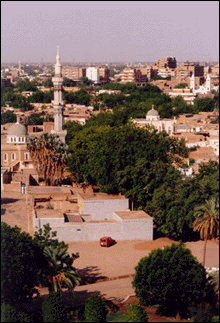
 Meroe Meroe |
See the chapter archaeological sites for more information!
On the east bank of the River Nile north east of Shendi, these ruins of pyramids, temples and palaces are remnants of the Meroitic era 350 BC to AD 350. The kingdom was influenced by Egyptian art and religion, but it became isolated, developing its own script and art. After weathering attacks by several tribes, the city was destroyed by the Christian kingdom of Axum (Ethiopia). Between the railway and the Nile, you will see ruins of the Amon Temple, and 2 km east of Meroe is the Temple of the Sun. The pyramids lie 5 km from the town. The nearest train station is in Kabushiya. Meroe is 70 km south of Shendi.
 Nuba Mountains Nuba Mountains |
This region south west of Khartoum is in an area that may be dangerous to visit, so check from reliable sources before venturing in. It is a beautiful region, and the residents; the Nuba tribe people have managed to maintain many of their traditional ways, although the government has a campaign under way to clothe them. If the opportunity arises, see one of the local dances or a rather violent wrestling match. Among the more interesting towns in the region are Rashad, Heiban, Kadugli and El Odaiya. Anyone visiting this area must have a lot of time, the roads are rough and transportation is unreliable. Take supplies, as food is scarce at some times of the year. It is 120 km south east of El Obeid.
 Omdurman Omdurman |
This old capital of the Sudan is the holiest city in the country. It has a population of 526 000 inhabitants and it is located right next to Khartoum.. It has a touch of old days and it is worth of a visit and to take a walk along its busy, noisy but exotic narrow streets where the market is held every day. For the sightseeing in Omdurman see the previous chapter on Khartoum and especially Mahdi Tomb, Khalifa House and the market. Don't miss the Dervish Dancing on the Nile Mosque on Fridays!
 Yala Yala |
At the end of the western railway from Khartoum, Nyala is the nearest rail station to Jebel Marra. Animals can be purchased here for treks through Jebel Marra. There is also a government rest house. Yala is 915 km west-southwest of Khartoum.
 Port Sudan Port Sudan |
The nation's principal port, population 207 000, on the Red Sea, has not got many attractions, and it is quite a run down place. However, it is the starting point for some of the world's best dive tours. 661 km of Khartoum.
 Shendi Shendi |
On the Nile north east of Khartoum, Shendi was a large 18th century market town. Now it is mainly visited on the way to the Meroitic ruins of the Naga and Musawwarat temples. Frequent bus service departs Khartoum. It is 175 km north east of Khartoum.
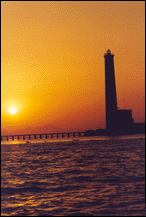
 Showak Showak |
In eastern Sudan, Showak is the Sudanese headquarters of the United Nations High Commissions for Refugees. Many refugee settlements may be found in this area. It is 137 km south west of Kassala.
 Suakin Suakin |
This ancient Red Sea port is now inhabited mostly by cats. The town, best visited as a trip from Port Sudan, is on an island connected to the mainland by a causeway. Of interest are the ruined buildings, made of coral. 64 km south of Port Sudan.
 Wadi Halfa Wadi Halfa |
The transit point of Wadi Halfa is to be endured, rather than enjoyed, while entering or leaving Egypt. There is not much to see, the highlight of the area is a Chinese fish processing plant. It is 930 km by road north of Khartoum.
 Wau Wau |
Founded at its present site by the French in the 1890's, this capital of Bhar-El-Ghazal Province sits at the end of the south west branch of the railway. It has a population of 116 000 people. Wau is in a largely Dinka tribal area that has been the long time centre of famine and war. There is a catholic mission in Wau. The city is 500 km north west of Juba.
 ARCHAEOLOGICAL SITES ARCHAEOLOGICAL SITES |
Of the most important archaeological sites in the river Nile State are those of the Meroitic Kingdom which flourished between the six century B.C. to the fourth century A.D. exemplified by the Royal City, Begrawwiya Pyramids, the Sun Temple, Wad Ben Naga, Naga and Muswwarat Essofra.
 The Royal City of Meroe The Royal City of Meroe |
The city of Meroe was known to the outside world since the Fifth Centruy B.C. through the writings of the Greek Traveller Herodotus. The most important buildings in the Royal City are the Kings palaces, Temples and the Royal Bath. Amun Temple is the largest building and one of the largest temples in the Sudan with many rooms and courtyards built with sand -stone, red brick and mud. The high standard of Architecture of Meroe was clearly seen in the building of the Royal Pyramids, Temples, Palaces and the Meroitic Royal Bath. The wealth of Meroe was based on iron industry and agricultural development. Meroe was a religious centre as there are many temples around the Kings Palace.
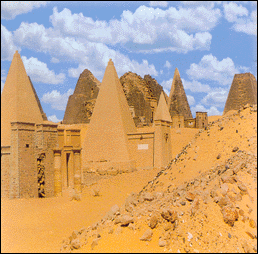
 Begrawwiya Pyramids Begrawwiya Pyramids |
The famous pyramids of the Meroitic Kings and queens, are erected above the Royal temples about 4 km to the East of the City of Meroe. But it is unfortunate that most of them were demolished in the 19th century by the Treasure Hunter Adventurer, Ferline.
 The Sun Temple The Sun Temple |
The Sun Temple which is of a unique type was found between the Royal City of Meroe and the Royal Pyramids. It was a religious and political temple where the Meroites used to celebrate their victories.
 Wad Ben Naga (127 km north of Khartoum) Wad Ben Naga (127 km north of Khartoum) |
Wad Ben Naga was located at the confluence of the Nile and Wadi Awatib within 600 km to the south of the Royal City of Meroe. The most important building is the place of Meroitic Queen Amanishakhete who ruled during the first Century B.C.
 Naga (40 km east Wad Ben Naga) Naga (40 km east Wad Ben Naga) |
There are many temples but the most important ones are the Lion Temple, Amun Temple, the Meroitic Kiosk, and Temples of Queen Shanakadakhete. The Lion and Amun Temples were built by King Natakamani and his wife queen Amanitare in the period between the First Century B.C. to the First Century A.D. The Lion Temple is a typical Meroitic temple for the Meroitic God Apedemak. The Meroitic Kiosk, in front of the Lion Temple was built by King Natakamani. |

